Serious talk about inkjet printers
Are you going to print a pack of pictures of your grandson for your beloved mother-in-law? I do not know about you, but I have to;)
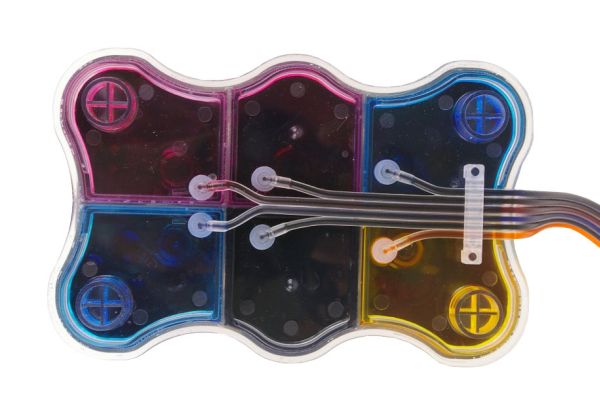
Saving on printing photos
Printers as a class of devices appeared a long time ago, but it was in greenhouse-home conditions that began to appear years since 1985. With each passing year, technology has evolved and become more sophisticated, new printing methods have appeared - you can read about this in a wonderful Wikipedia article :)
A decade ago, a printer at home was a sign of prosperity - inkjet printers often stood almost in a prominent place and printed a couple of sheets per week - the owners, with enviable constancy, worried about the ink level and in every possible way saved on print quality. Or didn’t you hear your question “Do not print the report? There are forty pages there ... ”abstract grumbling? ) Some proudly printed for the first time, and said the second time, saying “something doesn’t work” - it seems like conscience is clean, and it seems like you don’t spend on paint))
Now everything has changed, you won’t surprise anyone with the printer - the competition between industry leaders (Epson , Canon, HP, Brother and Lexmark - they own 97% of the inkjet printer market) made them more accessible than ever - for a couple of thousand rubles you can take a printer that will satisfy all “home” needs in quality. Bundles can print not only color text, but also photos - cartridges cost a penny, the choice of photo devices is huge - come to the store, choose.
Stop! Cartridges for a penny? Hmm ... about a year ago I bought a wonderful laser printer for studySamsung ML-1630 - it cost something about 5000 rubles. And everything seems to be fine ... but I found a buried dog only by printing a pack of paper - new toner cartridges for it cost 3000 rubles (!) With a resource of 2000 pages! Yes, although I was going to talk about inkjets, but the sediment remained!
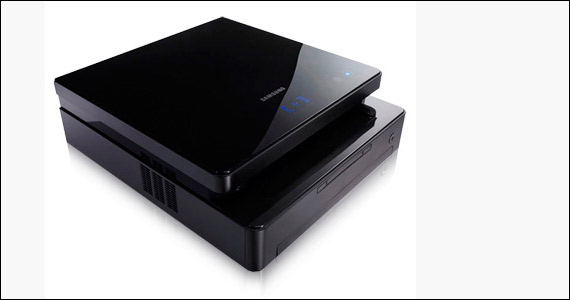
So, the situation on the inkjet printer market is about the same - sometimes expensive consumables and maintenance are hidden behind a cheap and high-quality device. For manufacturers, this is a natural process - in competitive races every time you have to “re-peep” colleagues, releasing more and more technically advanced devices, then “beating” money on cartridges. The analogy is if car manufacturers sold cars for $ 30 apiece, and the fuel they drive for $ 1000. And the volume of the cartridge in each new model of printer or MFP seems to be not even going to grow.
For us, mere mortals, this is an excellent “divorce” scheme - in the store we pay attention to anything — the quality of the image we issue, the speed and noise, all kinds of screens and other checkers there ... but not the cartridge resource and its replacement. And the seller is silent as partisans - in order to sell more, so that in a month or two you will return to him. It’s good if you are an advanced IT user or just a person who is keen on printing photos - you naturally read the reviews in advance, calculate the price of one print on a piece of paper with the price of the cartridge and the print settings you need, look at the availability and price of consumables with the prospect of consumables on online stores near future ... but if everyone did that.
And users began to think ... more precisely, other companies began to think for them (different from printer manufacturers, of course). These same companies began to come up with alternative methods that seem to make life easier for the simple user.
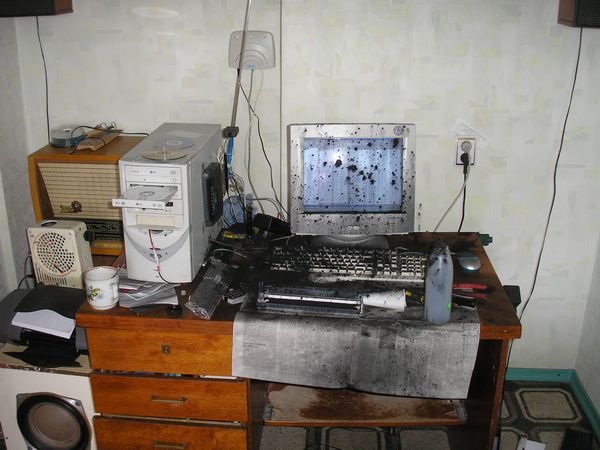
Suppose the cost of one cartridge for a printer is $ 25-30 and on average it contains 7-8 ml of ink. It turns out, ~ $ 4 per one ml, while the market price of ink in a can (but of the highest quality) is about $ 30 per 1000 ml (but not $ 4000 in any way). It was this preponderance that at one time became the impetus for the development of non-original consumables.
Perhaps the prototype of solving the problem was all kinds of “package packages” - small boxes for different models of printers, containing syringes-containers with the right paint. To extend the life of the cartridge, the user at his own risk was offered to refill it through these same syringes. What percentage of equipment failure after such operations is unknown to me, but for me, pah-pah, everything always worked. By the way, I remember the situations when I had to “revive” a dried cartridge due to its inactive use. Sit, happened, with a rag and a bottle of distilled water, covered with paint - rubbed gloss nozzle, and when the test run some color still can notprosirat "wakes up". You could conjure whole evenings.

Technology did not stand still - manufacturers began to make cartridges with all kinds of chips, which, for example, due to irreversible processes, made refueling impossible. And since absolute protection does not exist even in the world of inkjet printer cartridges, the market responded quickly enough by starting to produce cartridges identical to the original ones. At a price they were 3-5 times cheaper than genuine ones, but they were still as low-consuming and still without any guarantees.

Engineering minds did not sleep, thought days and nights ... and as a result came up with. This time, continuous ink supply technology began to gain momentum (abbreviated as CISSor Continuous Ink Supply Systems, CISS). We can’t say that she changed everything right at the root - the syringes and containers still remained ... At first they were all kinds of tubes connected with tubes and scotch tape with home-made “droppers”, now these are serial products of large companies produced in factories and for which they provide guarantees. In short, life seemed to be easier and I would like to talk a little about it.
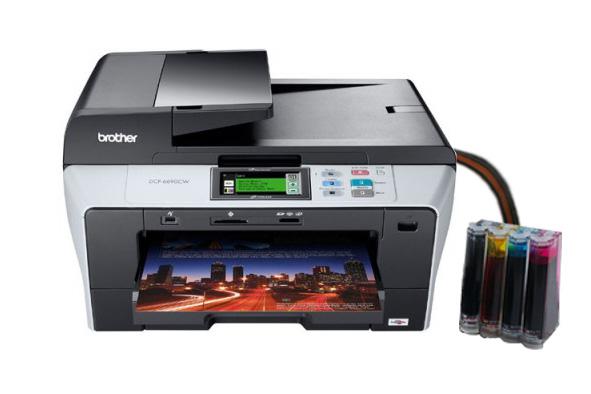
The device and the principle of operation of the CISS is not complicated and practically does not differ from the original device: large tanks are installed outside the printer, ink from which are fed to the print heads via a thin silicone ribbon cable. All.
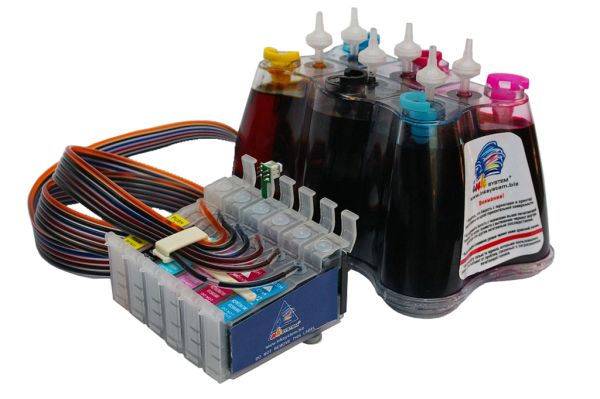
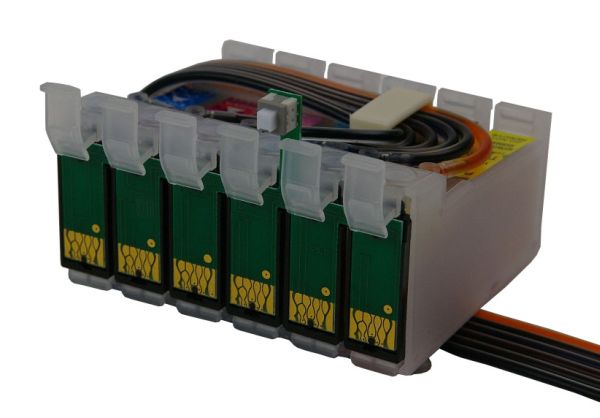
What is the gain? Well, at least in the volume of the tanks - you can print longer without worrying about the need to change something. Secondly, the volumes are always in sight and you can replenish any of the colors independently of the others. Thirdly, the price, about which a little later.
Those. we have the same printer (multifunction printer or plotter), but with a little modified cartridges - after the ink is finished no replacement is required, all that is needed is to add ink like gasoline to the car.
As you can see, there is no acceleration or deceleration of the printing process, although the resource of the print head is possibly increasing - there is no "heaviness" in the face of the cartridge and there are no periodic actions to replace anything.
Refueling such a system is not much different from the fuss that was before. The same syringe, the same jars ... but the difference is that now the paint must be “injected” not blindly into the cartridge (when you can guess, poured or underfilled), but into a transparent container (you can even just fill it up, without any syringes). Actually, the paint consumption is estimated from the same containers and, if necessary, the desired color is refilled.
Suppose the capacity of one black cartridge (8 ml) is enough to print 1000 sheets of text at 5% coverage. For ease of calculation, we accept the price of such a cartridge at $ 30, and the dollar exchange rate for 30 rubles.
In CISS kits, the volume of the ink bottle is usually 100 ml for each color. That is, a 6-color printer is 600 ml, and a 4-color printer is 400 ml. Even if the “dose” during refueling is not 8, but 10 ml, 10,000 sheets of text will be able to print. If you use ink at an average price of $ 5 per 100 ml, then the cost of one copy excluding the price of paper will be 5/10000 = $ 0.0005 (0.015 rubles = one and a half penny).
In order to print the same amount of text when using the original cartridges, they will need 10 pieces ($ 300), which is $ 0.03 per page (90 cents). Savings - 60 times, with equal print quality (judging by the video. Or is it a lie?).
The calculations are extremely approximate - the cost of the CISS itself was not taken into account. And if you print pictures, the cost of paper will be the main item of expenditure ... but saving on paint even by 2 times is ALREADY a saving. You can calculate the real savings for your printer yourself, relying on the price of a new cartridge and a CISS system, the price of which can be found on the internet (a lot of things, for example, on this site).
It’s logical to assume that manufacturers don’t like such a move with a knight - so there’s nothing the surprising thing is that they are trying in every way to protect the printing mechanism and in any case will deprive you of warranty service. On the other hand, the printer will pay off very soon, even if you do not profit from its work.

Original cartridges
Pros :
- The print quality that was “designed” by the manufacturer;
- The possibility of warranty service
- A clear conscience.
Cons :
- High cost;
- Small volume of capacities for ink;
- The need to interrupt printing when replacing a cartridge;
- If the cartridge is solid, then it will have to be completely replaced, even if only one color is over.
CISS - Continuous ink supply systems
Pros :
- Ability to replenish ink volume in accordance with their actual consumption;
- Print quality similar to the original;
- Low cost of the system and consumables;
- A large volume of ink tanks;
- Possibility of continuous printing.
Cons :
- Scary appearance) the complexity of transporting the printer with the CISS installed;
- There is a chance to lose warranty service.
Regarding the appearance - CISS are completely unsightly containers that stick out of the printer with a "black sheep". If I had such an aggregate - I would have stuck them in every way)
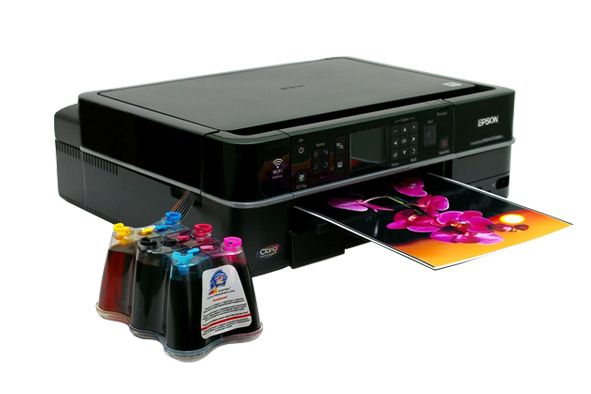
Lazily people wander around shopping centers,
For a ruble with something, they take equipment at interest.
It would have been like this, if only the brain hadn’t swum with fat ...
To whom it’s hard - hold on, I wish you peace!
Words from one of the songs on Caste's latest album. If you think about it - really ... marketers just won’t come up with something. Some come up with pitfalls in the devices themselves, others with their sale. And many are blindly being led to this, thinking, " Why what, all the printers are the same, why overpay ."
A “good printer” can really be bought at a very affordable price. Another question is what it will pour out later, with active use. And if you have already managed to get caught, it is possible that these very CISS will help you get out. Another question is that they do not exist for every printer and it would be better to think it over in advance :) Obviously, this is a very profitable investment. Well, or buy a printer / MFP right away with the CISS installed, since there are such offers on the market too.
Now manufacturers are struggling in every way with the “foreign body in their body”, complicating the design of covers and making access to the printing mechanism more difficult - it seems that printers will soon look like black boxes :) However, time will tell.
Or what else to expect? )
My Success Twitter

Saving on printing photos
Printers as a class of devices appeared a long time ago, but it was in greenhouse-home conditions that began to appear years since 1985. With each passing year, technology has evolved and become more sophisticated, new printing methods have appeared - you can read about this in a wonderful Wikipedia article :)
A decade ago, a printer at home was a sign of prosperity - inkjet printers often stood almost in a prominent place and printed a couple of sheets per week - the owners, with enviable constancy, worried about the ink level and in every possible way saved on print quality. Or didn’t you hear your question “Do not print the report? There are forty pages there ... ”abstract grumbling? ) Some proudly printed for the first time, and said the second time, saying “something doesn’t work” - it seems like conscience is clean, and it seems like you don’t spend on paint))
Now everything has changed, you won’t surprise anyone with the printer - the competition between industry leaders (Epson , Canon, HP, Brother and Lexmark - they own 97% of the inkjet printer market) made them more accessible than ever - for a couple of thousand rubles you can take a printer that will satisfy all “home” needs in quality. Bundles can print not only color text, but also photos - cartridges cost a penny, the choice of photo devices is huge - come to the store, choose.
Stop! Cartridges for a penny? Hmm ... about a year ago I bought a wonderful laser printer for studySamsung ML-1630 - it cost something about 5000 rubles. And everything seems to be fine ... but I found a buried dog only by printing a pack of paper - new toner cartridges for it cost 3000 rubles (!) With a resource of 2000 pages! Yes, although I was going to talk about inkjets, but the sediment remained!

So, the situation on the inkjet printer market is about the same - sometimes expensive consumables and maintenance are hidden behind a cheap and high-quality device. For manufacturers, this is a natural process - in competitive races every time you have to “re-peep” colleagues, releasing more and more technically advanced devices, then “beating” money on cartridges. The analogy is if car manufacturers sold cars for $ 30 apiece, and the fuel they drive for $ 1000. And the volume of the cartridge in each new model of printer or MFP seems to be not even going to grow.
For us, mere mortals, this is an excellent “divorce” scheme - in the store we pay attention to anything — the quality of the image we issue, the speed and noise, all kinds of screens and other checkers there ... but not the cartridge resource and its replacement. And the seller is silent as partisans - in order to sell more, so that in a month or two you will return to him. It’s good if you are an advanced IT user or just a person who is keen on printing photos - you naturally read the reviews in advance, calculate the price of one print on a piece of paper with the price of the cartridge and the print settings you need, look at the availability and price of consumables with the prospect of consumables on online stores near future ... but if everyone did that.
And users began to think ... more precisely, other companies began to think for them (different from printer manufacturers, of course). These same companies began to come up with alternative methods that seem to make life easier for the simple user.

EsEnPeCho ?!
Suppose the cost of one cartridge for a printer is $ 25-30 and on average it contains 7-8 ml of ink. It turns out, ~ $ 4 per one ml, while the market price of ink in a can (but of the highest quality) is about $ 30 per 1000 ml (but not $ 4000 in any way). It was this preponderance that at one time became the impetus for the development of non-original consumables.
Perhaps the prototype of solving the problem was all kinds of “package packages” - small boxes for different models of printers, containing syringes-containers with the right paint. To extend the life of the cartridge, the user at his own risk was offered to refill it through these same syringes. What percentage of equipment failure after such operations is unknown to me, but for me, pah-pah, everything always worked. By the way, I remember the situations when I had to “revive” a dried cartridge due to its inactive use. Sit, happened, with a rag and a bottle of distilled water, covered with paint - rubbed gloss nozzle, and when the test run some color still can not

Technology did not stand still - manufacturers began to make cartridges with all kinds of chips, which, for example, due to irreversible processes, made refueling impossible. And since absolute protection does not exist even in the world of inkjet printer cartridges, the market responded quickly enough by starting to produce cartridges identical to the original ones. At a price they were 3-5 times cheaper than genuine ones, but they were still as low-consuming and still without any guarantees.

Engineering minds did not sleep, thought days and nights ... and as a result came up with. This time, continuous ink supply technology began to gain momentum (abbreviated as CISSor Continuous Ink Supply Systems, CISS). We can’t say that she changed everything right at the root - the syringes and containers still remained ... At first they were all kinds of tubes connected with tubes and scotch tape with home-made “droppers”, now these are serial products of large companies produced in factories and for which they provide guarantees. In short, life seemed to be easier and I would like to talk a little about it.

Arbeiten
The device and the principle of operation of the CISS is not complicated and practically does not differ from the original device: large tanks are installed outside the printer, ink from which are fed to the print heads via a thin silicone ribbon cable. All.


What is the gain? Well, at least in the volume of the tanks - you can print longer without worrying about the need to change something. Secondly, the volumes are always in sight and you can replenish any of the colors independently of the others. Thirdly, the price, about which a little later.
Those. we have the same printer (multifunction printer or plotter), but with a little modified cartridges - after the ink is finished no replacement is required, all that is needed is to add ink like gasoline to the car.
As you can see, there is no acceleration or deceleration of the printing process, although the resource of the print head is possibly increasing - there is no "heaviness" in the face of the cartridge and there are no periodic actions to replace anything.
Refueling such a system is not much different from the fuss that was before. The same syringe, the same jars ... but the difference is that now the paint must be “injected” not blindly into the cartridge (when you can guess, poured or underfilled), but into a transparent container (you can even just fill it up, without any syringes). Actually, the paint consumption is estimated from the same containers and, if necessary, the desired color is refilled.
Broken calculator
Suppose the capacity of one black cartridge (8 ml) is enough to print 1000 sheets of text at 5% coverage. For ease of calculation, we accept the price of such a cartridge at $ 30, and the dollar exchange rate for 30 rubles.
In CISS kits, the volume of the ink bottle is usually 100 ml for each color. That is, a 6-color printer is 600 ml, and a 4-color printer is 400 ml. Even if the “dose” during refueling is not 8, but 10 ml, 10,000 sheets of text will be able to print. If you use ink at an average price of $ 5 per 100 ml, then the cost of one copy excluding the price of paper will be 5/10000 = $ 0.0005 (0.015 rubles = one and a half penny).
In order to print the same amount of text when using the original cartridges, they will need 10 pieces ($ 300), which is $ 0.03 per page (90 cents). Savings - 60 times, with equal print quality (judging by the video. Or is it a lie?).
The calculations are extremely approximate - the cost of the CISS itself was not taken into account. And if you print pictures, the cost of paper will be the main item of expenditure ... but saving on paint even by 2 times is ALREADY a saving. You can calculate the real savings for your printer yourself, relying on the price of a new cartridge and a CISS system, the price of which can be found on the internet (a lot of things, for example, on this site).
It’s logical to assume that manufacturers don’t like such a move with a knight - so there’s nothing the surprising thing is that they are trying in every way to protect the printing mechanism and in any case will deprive you of warranty service. On the other hand, the printer will pay off very soon, even if you do not profit from its work.

Pros and cons?
Original cartridges
Pros :
- The print quality that was “designed” by the manufacturer;
- The possibility of warranty service
- A clear conscience.
Cons :
- High cost;
- Small volume of capacities for ink;
- The need to interrupt printing when replacing a cartridge;
- If the cartridge is solid, then it will have to be completely replaced, even if only one color is over.
CISS - Continuous ink supply systems
Pros :
- Ability to replenish ink volume in accordance with their actual consumption;
- Print quality similar to the original;
- Low cost of the system and consumables;
- A large volume of ink tanks;
- Possibility of continuous printing.
Cons :
- Scary appearance) the complexity of transporting the printer with the CISS installed;
- There is a chance to lose warranty service.
Regarding the appearance - CISS are completely unsightly containers that stick out of the printer with a "black sheep". If I had such an aggregate - I would have stuck them in every way)

Verdict
Lazily people wander around shopping centers,
For a ruble with something, they take equipment at interest.
It would have been like this, if only the brain hadn’t swum with fat ...
To whom it’s hard - hold on, I wish you peace!
Words from one of the songs on Caste's latest album. If you think about it - really ... marketers just won’t come up with something. Some come up with pitfalls in the devices themselves, others with their sale. And many are blindly being led to this, thinking, " Why what, all the printers are the same, why overpay ."
A “good printer” can really be bought at a very affordable price. Another question is what it will pour out later, with active use. And if you have already managed to get caught, it is possible that these very CISS will help you get out. Another question is that they do not exist for every printer and it would be better to think it over in advance :) Obviously, this is a very profitable investment. Well, or buy a printer / MFP right away with the CISS installed, since there are such offers on the market too.
Now manufacturers are struggling in every way with the “foreign body in their body”, complicating the design of covers and making access to the printing mechanism more difficult - it seems that printers will soon look like black boxes :) However, time will tell.
Or what else to expect? )
My Success Twitter
